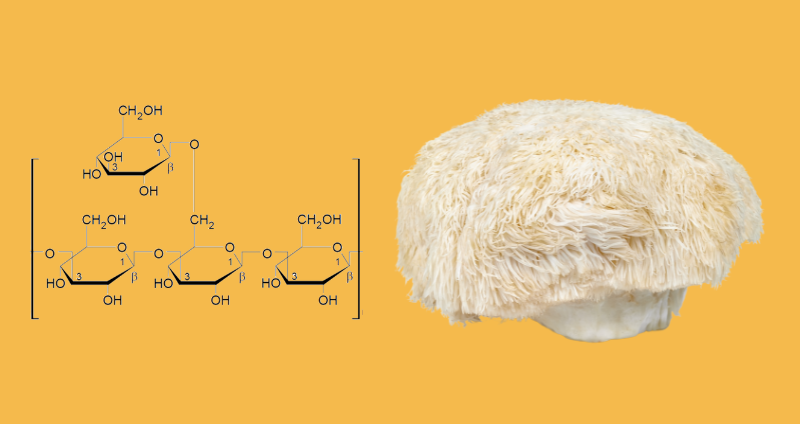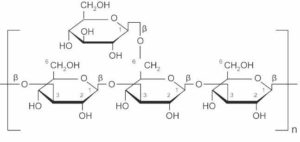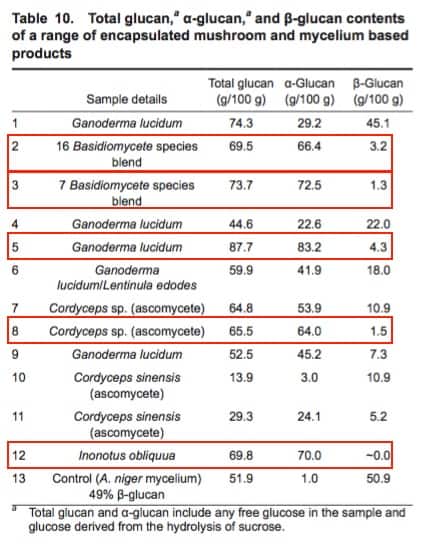Menu



Polysaccharides are one of the key active components in medicinal mushrooms and they are commonly listed on many medicinal mushroom products. In fact, many companies boast about high polysaccharide numbers.
However, if we look deeper it becomes clear that polysaccharide analysis may be hiding significant product flaws. Mushroom polysaccharides have been studied for their effects on gut microbiota composition, but this doesn't necessarily indicate overall product quality. [6]
Are high polysaccharides really a measure of quality?
Actually polysaccharides include more than just compounds found in mushrooms which means many mushroom products are fooling you with their polysaccharide numbers. The impact of mushroom polysaccharides on gut health is complex and involves the production of short chain fatty acids. [7]
But first…
Polysaccharides are long chain carbohydrates that have the structural characteristics of various monosaccharides connected by glycosidic bonds. These molecules can range from the very simple to the more complex carbohydrate molecules. Research in food chem has shown that some polysaccharides may help reduce oxidative stress. [8]
Some examples of polysaccharides would be chitin and beta-glucans, which make up the cell walls of fungi. Cellulose, which is what plant cell walls are made up of are also polysaccharides. Starch and glycogen are also polysaccharides.
Polysaccharides are considered to be one of the most commonly mentioned active compounds in plants and fungi. Specific types of mushrooms like reishi (Ganoderma lucidum), turkey tail (Trametes versicolor) and Maitake (Grifola frondosa) possess high levels of polysaccharides.

Now that we’ve defined what polysaccharides are, we will look specifically at the polysaccharides you find in fungi. Fungi will contain small amounts of glycogen, but the primary polysaccharides are beta-D-glucans.
Beta-glucans come in various forms, but the main one in fungi have what is known as 1-3,1-6 branching also referred to as (1-3)(1-6)beta-d-glucans. These are specific to fungi and yeast. Oats also contain beta-glucans, but they have a different branching structure, which are (1-4)beta-d-glucans.
This is important because the bulk of the medicinal mushroom research is based on the effects of these beta-glucans. Interestingly, the metabolism of these compounds in the gut can influence the production and absorption of free fatty acids and play a role in lipid metabolism. [ 9 10]
While not directly related to polysaccharide content, the interaction between beta-glucans and free fatty acids in the digestive system may contribute to some of the observed health effects of mushroom consumption.
If the important compounds are beta-glucans, why are companies still measuring polysaccharides?
Another group of polysaccharides are alpha-glucans. These are compounds like glycogen, dextran, pullulan and starch. What we've discovered is that the polysaccharides in many so-called mushroom products are made up of alpha-glucans and not beta-glucans.

If you look at the table above, you will see an alpha-glucan and beta-glucan breakdown of various medicinal mushroom products. Take note of specific mushroom products like sample #5, which is Reishi (Ganoderma lucidum).
This particular sample tests high in alpha-glucans and very low in beta-glucans. Another prime example would be sample #12, which is Chaga (Inonotus obliquus). It expresses high amounts of alpha-glucans and little if any beta-glucans. Same applies for sample #8, Cordyceps sp. (ascomycete), which is dominated by high alpha glucans and small amounts of beta-glucans. The Nammex report also showed similar results. These findings are significant because mushroom polysaccharides have been studied for their potential effects on the immune system and intestinal microbiota. [6, 7]
On paper these products can tout high polysaccharide amounts (alpha-glucans + beta-glucans) but in reality the majority of those polysaccharides come from alpha-glucans in the form of starches and fillers. Those alpha-glucans provide no medicinal benefit. Research in food chem has shown that the molecular weight of mushroom polysaccharide compounds can influence their bioactivity. [11]
This concept is extremely important to understand when it comes to medicinal mushroom products. It is quite concerning because many products on the market tout polysaccharide numbers yet fail to mention any beta-glucan numbers. Studies have suggested that certain mushroom polysaccharides may help maintain intestinal barrier function, especially in the context of a high fat diet. [11, 12]
As the beta-glucans are the important polysaccharide in these fungi, it is vital that beta-glucan testing be done instead of polysaccharide testing to properly qualify medicinal mushroom products.
The Megazyme method, developed by Dr. Barry McCleary at Megazyme International, has been used by the USDA and other peer-reviewed research papers to precisely measure the beta-glucan and alpha-glucan content in mushrooms.
It can test all types of basidiomycete products like mushroom powders, mushroom extracts and mycelium powders. It detects soluble and insoluble (1-3)(1-6)beta-D-glucans and even quantifies the alpha-glucans, which are starches, so we can see if products contain fillers like grain.
A common trend you see in the medicinal mushroom industry are various brands claiming that their medicinal mushrooms products contain high amounts of polysaccharides. This looks and sounds great on paper but this can be very misleading considering that polysaccharides can also come from starches.
For example, products#2, 3, 8 and 12 in the table above are actually mycelium products that are grown on grain. They all can tout >60% polysaccharides but the polysaccharides are mainly coming from alpha-glucans in the form of grain starch and the products contain very little beta-glucans. Thus, the majority of your money is spent on alpha-glucans instead of beta-glucans, leaving you with a less potent medicinal mushroom product that is primarily grain.
This is why it’s imperative that you do your own research into exactly how the product is made and make sure to look for products that measure beta-glucans. Beware that products grown in North America are almost always mycelium grown on grain.
If you're curious, for less than $5 you can perform an iodine starch test on your medicinal mushroom product to verify if it contains any starchy fillers.
It is extremely important to understand that there is a difference in polysaccharides and that measuring polysaccharides for medicinal mushroom products is meaningless. High polysaccharides is not an indicator of quality and could actually be an indicator of poor quality.
A medicinal mushroom product should quantify the beta-glucans so you know the important medicinal compounds that much of the research is based around are present. This will help you in making an honest decision when selecting the right mushroom product.
At Real Mushrooms, we use the Megazyme method to measure beta-glucans and starch on all our products to show the potency and to confirm that they contain no fillers or grains.
Have questions or comments? Ask us below.
 .
.Disclaimer: The information or products mentioned in this article are provided as information resources only, and are not to be used or relied on to diagnose, treat, cure, or prevent any disease. This information does not create any patient-doctor relationship, and should not be used as a substitute for professional diagnosis and treatment. The information is intended for health care professionals only. The statements made in this article have not been evaluated by the Food and Drug Administration. Any products mentioned are not intended to diagnose, treat, cure, or prevent any disease. The information in this article is intended for educational purposes. The information is not intended to replace medical advice offered by licensed medical physicians. Please consult your doctor or health practitioner for any medical advice.